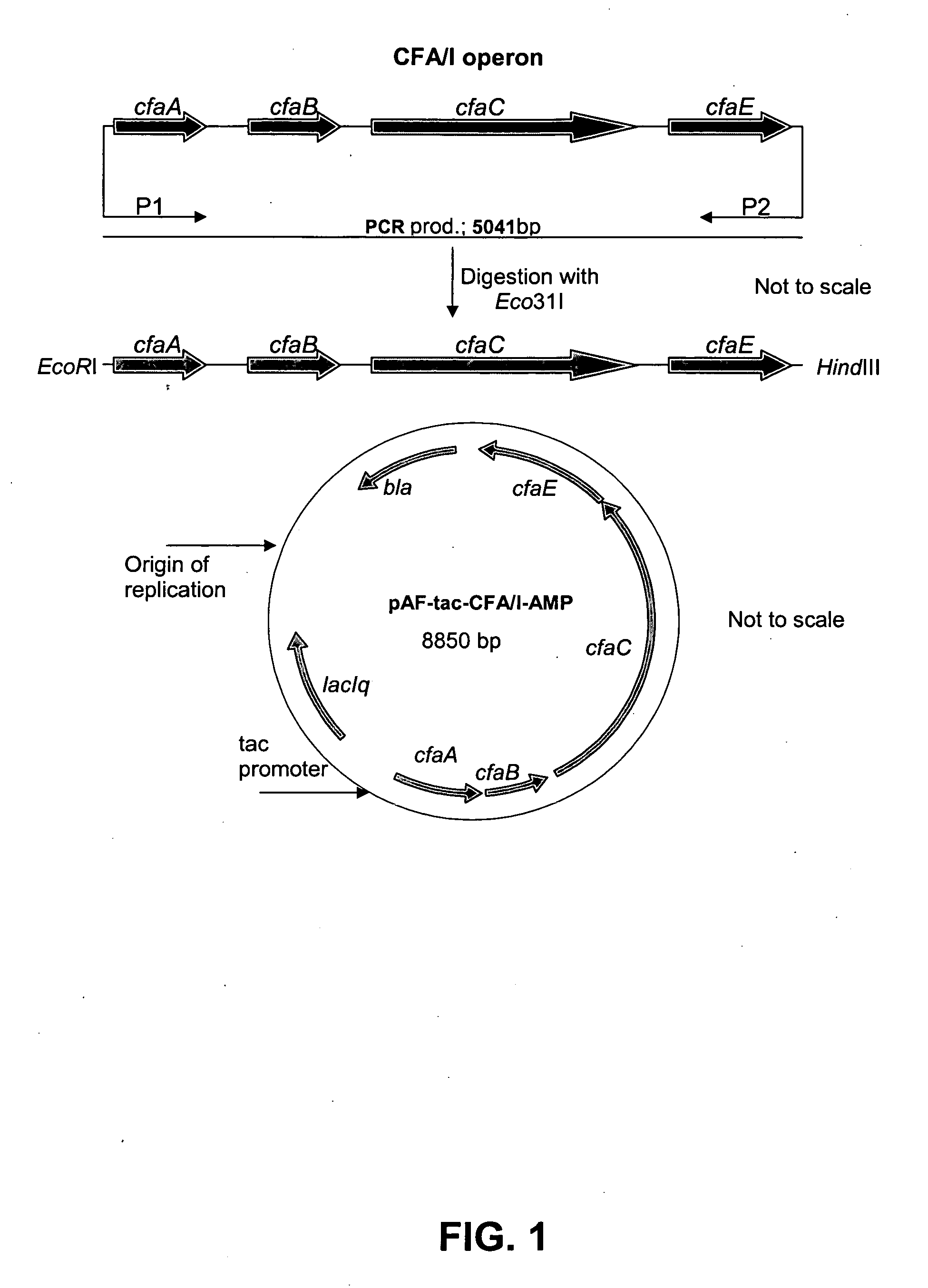Colonization factor (CF) antigens of enterotoxigenic escherichia coli in recombinant bacteria
a technology of colonization factor and enterotoxigenic escherichia coli, which is applied in the field of recombinant bacterial cells, can solve the problems of low protection effect of etec vaccine in egyptian infants 6 to 18 months of age, and insufficient potency to protect infants living in endemic areas
- Summary
- Abstract
- Description
- Claims
- Application Information
AI Technical Summary
Benefits of technology
Problems solved by technology
Method used
Image
Examples
example 1
Construction of a Recombinant Strain Over-Expressing CFA / I
[0093]The construction of E. coli strains with the capacity to over-express ETEC CF antigens on the bacterial surface is here exemplified with the description of the generation of such a strain, which when grown in vitro under appropriate cultivation conditions, can produce an excessive quantity of E. coli colonization factor antigen I (CFA / I). The approach taken was to clone the entire CFA / I operon, consisting of four genes, from a CFA / I producing wild-type ETEC strain into a plasmid expression vector, and then to introduce this plasmid into the E. coli K12 (E. coli TOP10) strain. This was accomplished by standard procedures for DNA manipulation, which were described by Sambrook and Russell (2001) or according to instructions supplied with reagents. PCR was used to amplify the relevant genes of the CFA / I operon from the CFA / I positive wild-type reference strain 325542-3. Template DNA was prepared by taking a fresh colony of ...
example 2
Demonstration of Over-Expression of CFs on the Surface of Recombinant E. coli K12 Strains
[0095]To determine the expression of different ETEC CFs on recombinant E. coli K12 strains, two different assays, i.e., dot blot and inhibition ELISA, were used. In the dot blot assay, 2 μl of two- or three-fold dilutions of whole bacteria in PBS in initial concentration of 109 bacteria / ml, were applied to a nitrocellulose membrane. Following incubation of the membrane with corresponding anti-CF MAb, the membrane was washed, incubated with anti-mouse IgG-horseradish peroxidase conjugate, and then developed as described in Materials and Methods. Expression of CFs on the bacterial surface of recombinant and reference strains was also determined by use of inhibition ELISA, in which the capacity of the CF on the respective strain to inhibit binding of corresponding anti-CF MAbs to solid-phase-bound CF is determined, as described in Inhibition ELISA for quantification of ETEC CFs / CS-factors.
[0096]The...
example 3
Introduction of a Non-Antibiotic Resistance Marker in the Recombinant CFA / I Over-Expressing E. coli K12 Strain (TOP10-CFA / I Strain)
[0098]A selection marker, like an antibiotic resistance marker, is needed for the maintenance of expression vectors in recombinant strains. However, to eliminate the possibility of antibiotic residues in vaccine preparations and to prevent the possibility of horizontal spread of genes encoding antibiotic resistance in the environment, such markers should be avoided in vaccine strains. We therefore replaced the β-lactamase gene (bla) present in pAF-thyA-CFA / 1-AMP with a non-antibiotic marker thyA (which complements a thyA mutation in the host and confers thymine independence on an otherwise thymine-dependent strain) in the over-expressing TOP10-CFA / I recombinant strain. A 1200 bp fragment carrying the thyA gene flanked by SalI and XhoI restriction sites was ligated into pAF-tac-CFA / 1-AMP digested with XhoI (FIG. 2). This resulted in the 10050 bp plasmid p...
PUM
| Property | Measurement | Unit |
|---|---|---|
| concentration | aaaaa | aaaaa |
| volume | aaaaa | aaaaa |
| temperature | aaaaa | aaaaa |
Abstract
Description
Claims
Application Information
 Login to View More
Login to View More - R&D
- Intellectual Property
- Life Sciences
- Materials
- Tech Scout
- Unparalleled Data Quality
- Higher Quality Content
- 60% Fewer Hallucinations
Browse by: Latest US Patents, China's latest patents, Technical Efficacy Thesaurus, Application Domain, Technology Topic, Popular Technical Reports.
© 2025 PatSnap. All rights reserved.Legal|Privacy policy|Modern Slavery Act Transparency Statement|Sitemap|About US| Contact US: help@patsnap.com



